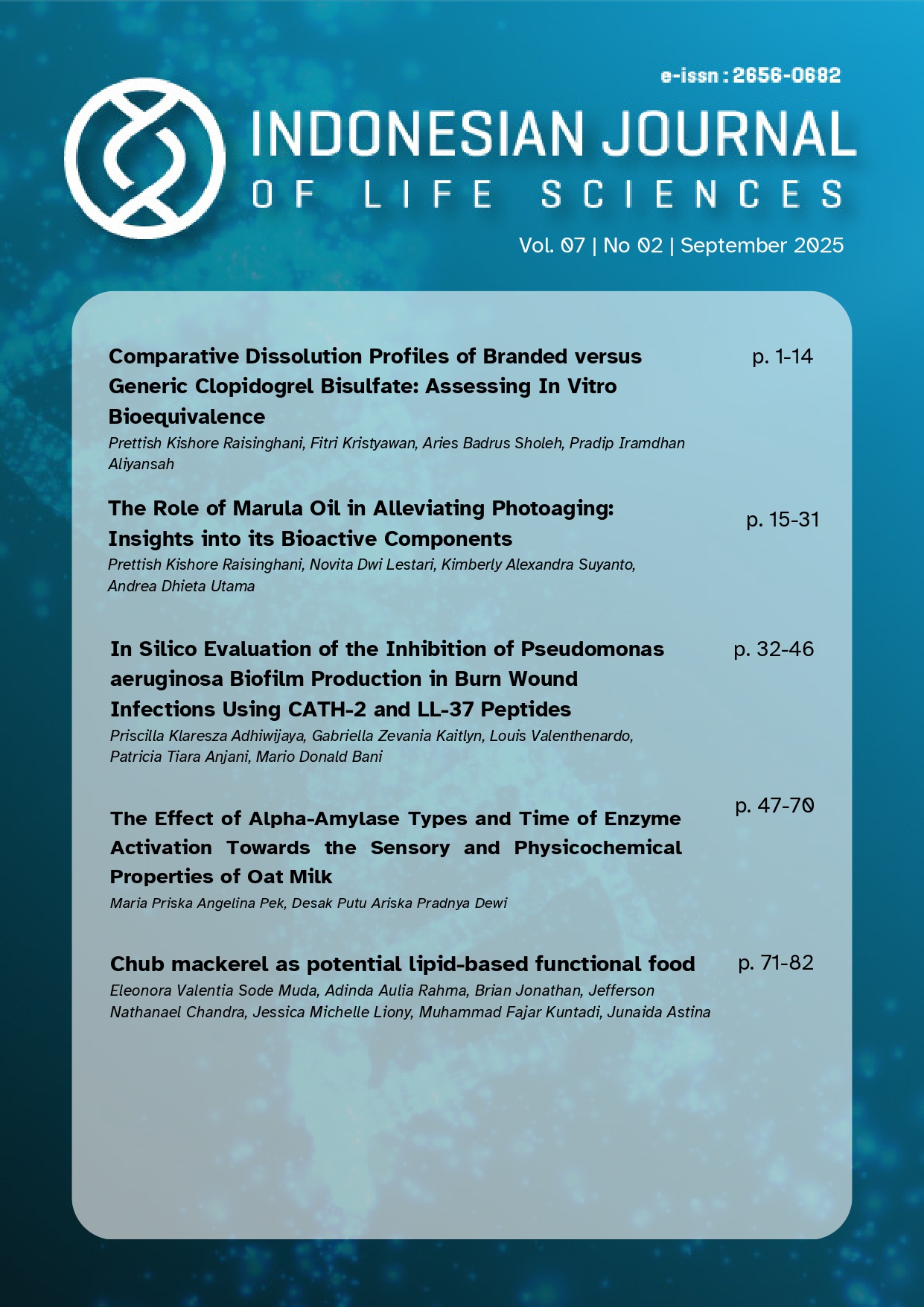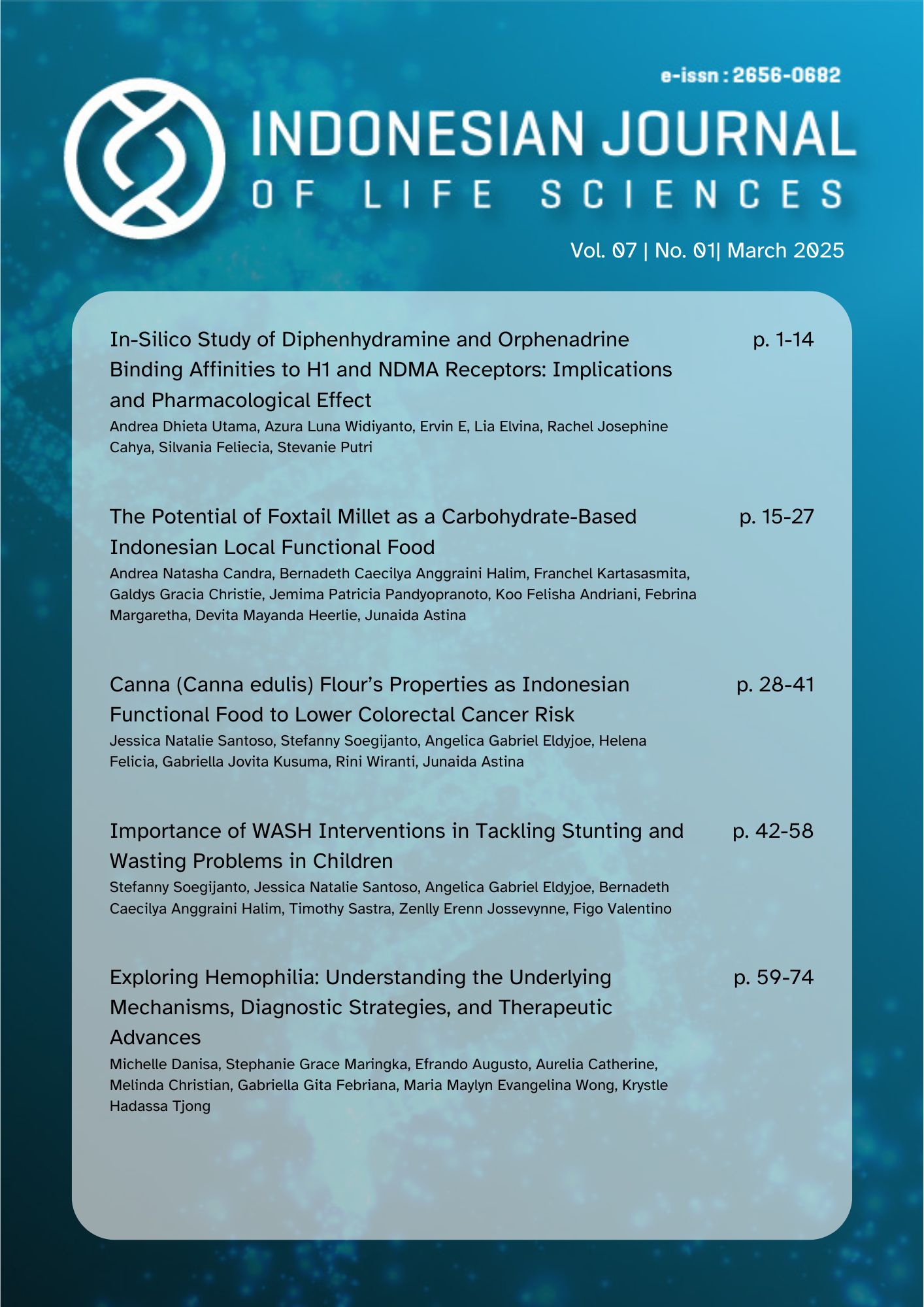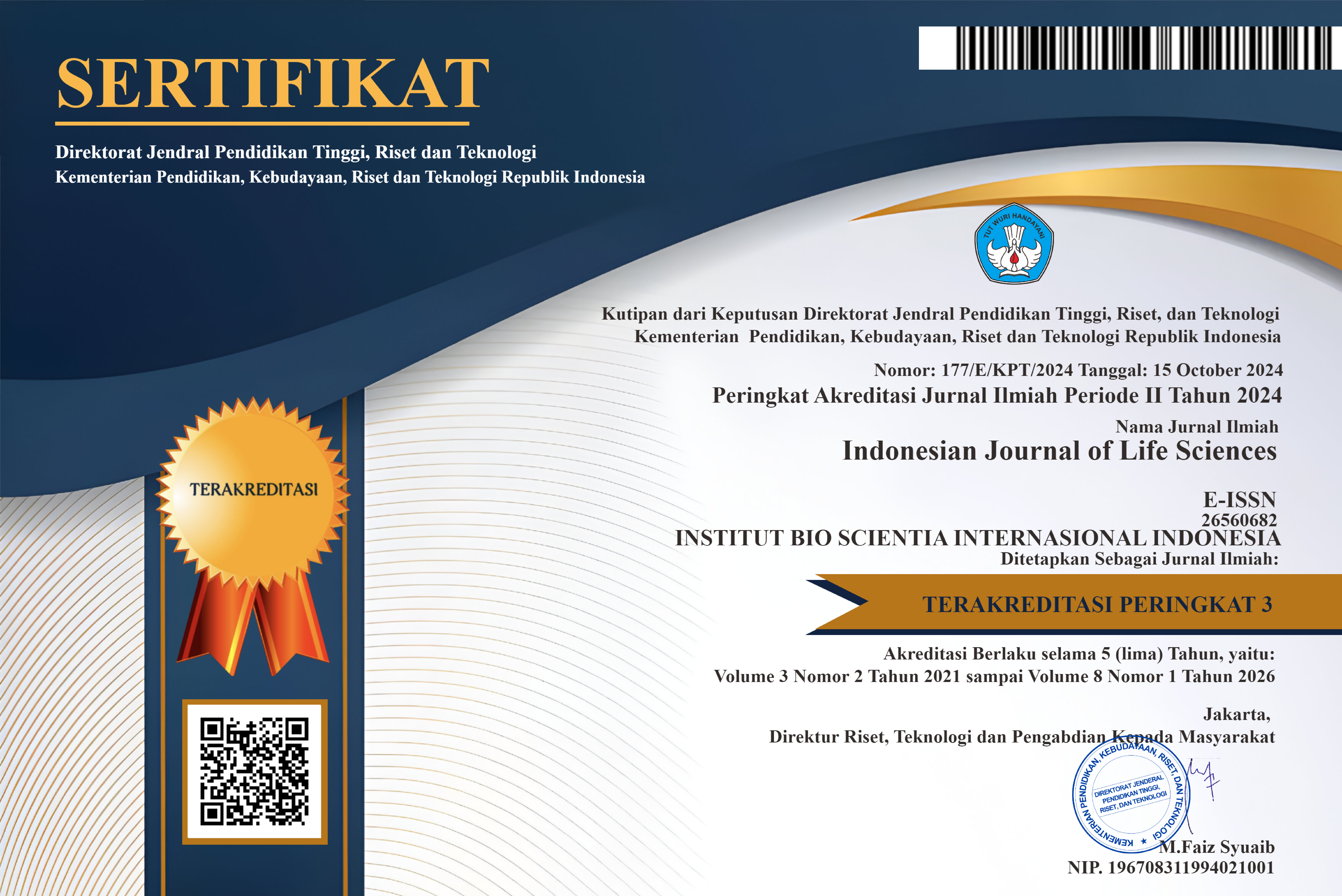Chub mackerel as potential lipid-based functional food
a comprehensive review
Abstract
Functional foods have gained a lot of attention as people become more aware of the importance of human nutrition. Chub mackerel is classified as one of the functional foods due to being rich in omega-3 fatty acids, which include eicosapentaenoic acid (EPA) and docosahexaenoic acid (DHA) that are associated with various health benefits, including anti-inflammatory properties, cardiovascular health support, and cognitive function enhancement. Additionally, chub mackerel also contains high protein, vitamin, and mineral content that contribute to muscle growth, immune system support, and cognitive function improvement. Research has indicated the safety and efficacy of consuming omega-3 from chub mackerel, particularly among vulnerable populations like pregnant women and children. Various processing techniques have been applied to chub mackerel to enhance its quality as a functional food, including roasting and frying. However, non-thermal processing may better preserve the nutritional compositions, mitigating nutrient losses during processing. The future outlook for chub mackerel as a functional food includes further research into alternative cooking methods to preserve omega-3 content and the implementation of regulatory measures and industry collaborations to promote its utilization as a functional food, particularly in regions like Indonesia where it is abundant and affordable. Overall, chub mackerel shows promise as a lipid-based functional food with significant potential for improving public health and addressing the rising prevalence of non-communicable diseases.
Downloads
References
Ahmmed, M. K., Ahmmed, F., Stewart, I., Carne, A., Tian, H., & Bekhit, A. E. A. (2021). Omega-3 phospholipids in Pacific blue mackerel (Scomber australasicus) processing by-products. Food Chemistry, 353, 129451. https://doi.org/10.1016/j.foodchem.2021.129451
al Saqqa, G. S. R. (2021). Some functional foods and benefits of their bioactive components. In JSSFN) Journal of the Saudi Society for Food and Nutrition (JSSFN) (Vol. 14, Issue 1).
Andhikawati, A., & Pratiwi, D. Y. (2020). Omega-3 fatty acid profiles of chub mackerel fish oil (Rastrelliger sp.) during cold storage. International Journal of Multidisciplinary Research and Development, 7(8), 19–22. https://www.allsubjectjournal.com/archives/2020/vol7/issue8/7-7-35
Balta, I., Ştef, L., Peț, I., Iancu, T., Ştef, D., & Corcionivoschi, N. (2021). Essential fatty acids as biomedicines in cardiac health. Biomedicines, 9(10), 1466. https://doi.org/10.3390/biomedicines9101466
Baker, M. T., Lu, P., Parrella, J. A., & Leggette, H. R. (2022). Consumer Acceptance toward Functional Foods: A Scoping Review. In International Journal of Environmental Research and Public Health (Vol. 19, Issue 3). https://doi.org/10.3390/ijerph19031217
Bastías, J. M., Balladares, P., Acuña, S., Quevedo, R., & Muñoz, O. (2017). Determining the effect of different cooking methods on the nutritional composition of salmon (Salmo salar) and chilean jack mackerel (Trachurus murphyi) fillets. PLOS ONE, 12(7), e0180993. https://doi.org/10.1371/journal.pone.0180993
Benvenga, S., Famà, F., Perdichizzi, L. G., Antonelli, A., Brenta, G., Vermiglio, F., & Moleti, M. (2022). Fish and the Thyroid: A Janus Bifrons Relationship Caused by Pollutants and the Omega-3 Polyunsaturated Fatty Acids. Frontiers in endocrinology, 13, 891233. https://doi.org/10.3389/fendo.2022.891233
Bi, X., Li, F., Liu, S., Jin, Y., Zhang, X., Yang, T., ... & Zhao, A. Z. (2017). ω-3 polyunsaturated fatty acids ameliorate type 1 diabetes and autoimmunity. The Journal of Clinical Investigation, 127(5), 1757-1771. https://doi.org/10.1172/JCI87388
Chen, C., Huang, H., Dai, Q.-Q., Ren, J., Cai, H.-H., Hu, W.-J., Zhang, X.-J., Zhong, W.-T., & Li, X.-Y. (2021). Fish consumption, long-chain omega-3 fatty acids intake and risk of stroke: An updated systematic review and meta-analysis. Asia Pacific Journal of Clinical Nutrition, 30(1), 140–152. https://doi.org/10.6133/apjcn.202103_30(1).0017
Colussi, G., Catena, C., Novello, M., Bertin, N., & Sechi, L. A. (2017). Impact of omega-3 polyunsaturated fatty acids on vascular function and blood pressure: Relevance for cardiovascular outcomes. Nutrition, Metabolism and Cardiovascular Diseases, 27(3), 191–200. https://doi.org/10.1016/j.numecd.2016.07.011
Ducruet, J., Rébénaque, P., Diserens, S., Kosińska-Cagnazzo, A., Héritier, I., & Andlauer, W. (2017). Amber ale beer enriched with goji berries – The effect on bioactive compound content and sensorial properties. Food Chemistry, 226, 109–118. https://doi.org/10.1016/j.foodchem.2017.01.047
Durmus, M. (2019). Fish oil for human health: Omega-3 fatty acid profiles of marine seafood species. Food Science and Technology, 39(suppl 2), 454–461. https://doi.org/10.1590/fst.21318
Essa, M. M., Bishir, M., Bhat, A., Chidambaram, S. B., Al-Balushi, B., Hamdan, H., Govindarajan, N., Freidland, R. P., & Qoronfleh, M. W. (2023). Functional foods and their impact on health. In Journal of Food Science and Technology (Vol. 60, Issue 3). https://doi.org/10.1007/s13197-021-05193-3
FAO (2018). State of World Fisheries and Aquaculture 2018 (SOFIA) (RUSSIAN EDITION) : meeting the sustainable development goals. FAO.
Ferreira, I., Falcato, F., Bandarra, N., & Rauter, A. P. (2022). Resolvins, Protectins, and Maresins: DHA-Derived Specialized Pro-Resolving Mediators, Biosynthetic Pathways, Synthetic Approaches, and Their Role in Inflammation. Molecules (Basel, Switzerland), 27(5), 1677. https://doi.org/10.3390/molecules27051677
Ferreira, I., Gomes-Bispo, A., Lourenço, H., Matos, J., Afonso, C., Cardoso, C., Castanheira, I., Motta, C., Prates, J. A., & Bandarra, N. M. (2020). The chemical composition and lipid profile of the chub mackerel (Scomber colias) show a strong seasonal dependence: Contribution to a nutritional evaluation. Biochimie, 178, 181-189. https://doi.org/10.1016/j.biochi.2020.09.022
Gow, R. V., & Hibbeln, J. R. (2014). Omega-3 fatty acid and nutrient deficits in adverse neurodevelopment and childhood behaviors. Child and Adolescent Psychiatric Clinics of North America, 23(3), 555–590. https://doi.org/10.1016/j.chc.2014.02.002
Groves, N. J., McGrath, J. J., & Burne, T. H. J. (2014). Vitamin D as a neurosteroid affecting the developing and adult brain. Annual Review of Nutrition, 34, 117–141. https://doi.org/10.1146/annurev-nutr-071813-105557
Hossain, M. A., & Yoshimatsu, T. (2014). Dietary calcium requirement in fishes. Aquaculture Nutrition, 20(1), 1–11. https://doi.org/10.1111/anu.12135
Hou, T. Y., McMurray, D. N., & Chapkin, R. S. (2016). Omega-3 fatty acids, lipid rafts, and T cell signaling. European Journal of Pharmacology, 785, 2-9. https://doi.org/10.1016/j.ejphar.2015.03.091
Khalid, W., Gill, P., Arshad, M. S., Ali, A., Ranjha, M. M. A. N., Mukhtar, S., Afzal, F., & Maqbool, Z. (2022). Functional behavior of DHA and EPA in the formation of babies brain at different stages of age, and protect from different brain-related diseases. International Journal of Food Properties, 25(1), 1021–1044. https://doi.org/10.1080/10942912.2022.2070642
Khorasani, A. (2016, March). Why is the pH increasing during fed-batch fermentation? ResearchGate; ResearchGate. https://www.researchgate.net/post/Why-is-the-pH-increasing-during-fed-batch-fermentation
Konstantinidi, M., & Koutelidakis, A. E. (2019). Functional Foods and Bioactive Compounds: A Review of Its Possible Role on Weight Management and Obesity’s Metabolic Consequences. Medicines, 6(3). https://doi.org/10.3390/medicines6030094
Kuberskaya, A. P., & Podgurskaya, V. V. (2023). Omega-3 fatty acids: promising plant sources and effects on the human body. Scientific Bulletin of the Omsk State Medical University, 9(1), 95-105.
Landel, V., Annweiler, C., Millet, P., Morello, M., & Féron, F. (2016). Vitamin D, cognition and alzheimer’s disease: The therapeutic benefit is in the d-tails. Journal of Alzheimer’s Disease, 53(2), 419–444. https://doi.org/10.3233/jad-150943
Lange, K. W. (2020). Omega-3 fatty acids and mental health. Global Health Journal, 4(1), 18–30. https://doi.org/10.1016/j.glohj.2020.01.004
Larrieu, T., & Layé, S. (2018). Food for mood: Relevance of nutritional omega-3 fatty acids for depression and anxiety. Frontiers in Physiology, 9(1047). https://doi.org/10.3389/fphys.2018.01047
Liu, J., Zeng, F.-F., Liu, Z.-M., Zhang, C.-X., Ling, W., & Chen, Y.-M. (2013). Effects of blood triglycerides on cardiovascular and all-cause mortality: A systematic review and meta-analysis of 61 prospective studies. Lipids in Health and Disease, 12(1). https://doi.org/10.1186/1476-511x-12-159
Motta, C., Rego, A., Cardoso, C., Coelho, I., Gomes-Bispo, A., Afonso, C., Prates, J. a. M., & Bandarra, N. M. (2021). Seasonality as experienced in the market and the resulting variation in the amino acid and elemental composition of chub mackerel (Scomber colias). Journal of Food Composition and Analysis, 104, 104151. https://doi.org/10.1016/j.jfca.2021.104151
Maulucci, G., Cohen, O., Daniel, B., Sansone, A., Petropoulou, P. I., Filou, S., ... & Sasson, S. (2016). Fatty acid-related modulations of membrane fluidity in cells: detection and implications. Free radical research, 50(sup1), S40-S50. https://doi.org/10.1080/10715762.2016.1231403
Nettleton, J. A., Brouwer, I. A., Geleijnse, J. M., & Hornstra, G. (2017). Saturated fat consumption and risk of coronary heart disease and ischemic stroke: A science update. Annals of Nutrition & Metabolism, 70(1), 26–33. https://doi.org/10.1159/000455681
Noureddine, N., Hartling, I., Wawrzyniak, P., Srikanthan, P., Lou, P. H., Lucchinetti, E., Krämer, S. D., Rogler, G., Zaugg, M., & Hersberger, M. (2022). Lipid emulsion rich in n-3 polyunsaturated fatty acids elicits a pro-resolution lipid mediator profile in mouse tissues and in human immune cells. The American journal of clinical nutrition, 116(3), 786–797. https://doi.org/10.1093/ajcn/nqac131
Nurwahyuni, A., Soewondo, P., Nadjib, M., Farianti, Y., Mukhlisa, M. N., Wahyuningsih, H., Mangunsong , E. R. M., Athiyah , Yunita, Sayekti, S. A. H., Sari, K., & Megraini, A. (2023). Health Care Spending for Cardiovascular Disease under National Health Insurance Scheme in Indonesia Before and During COVID-19: Descriptive Analysis and Policy Recommendations. JOURNAL of INDONESIAN HEALTH POLICY and ADMINISTRATION, 8(2), 79–88.
Ohshimo, S., Hiraoka, Y., Suyama, S., Tsuji, T., Yukami, R., Yasuda, T., & Ando, Y. (2022). Geographical differences in stable isotope ratios and fatty acid and lipid signatures of chub mackerel, Scomber japonicus, in waters around Japan. Bulletin of Marine Science, 98(3), 247–270. https://doi.org/10.5343/bms.2021.0043
Olaniran, A. O., Hiralal, L., Mokoena, M. P., & Pillay, B. (2017). Flavour-active volatile compounds in beer: production, regulation and control. Journal of the Institute of Brewing, 123(1), 13–23. https://doi.org/10.1002/jib.389
Oppedisano, F., Macrì, R., Gliozzi, M., Musolino, V., Carresi, C., Maiuolo, J., Bosco, F., Nucera, S., Zito, M. C., Guarnieri, L., Scarano, F., Nicita, C., Coppoletta, A. R., Ruga, S., Scicchitano, M., Mollace, R., Palma, E., & Mollace, V. (2020). The Anti-Inflammatory and Antioxidant Properties of n-3 PUFAs: Their Role in Cardiovascular Protection. Biomedicines, 8(9). https://doi.org/10.3390/biomedicines8090306
Oscarsson, J., & Hurt-Camejo, E. (2017). Omega-3 fatty acids eicosapentaenoic acid and docosahexaenoic acid and their mechanisms of action on apolipoprotein b-containing lipoproteins in humans: A review. Lipids in Health and Disease, 16(1). https://doi.org/10.1186/s12944-017-0541-3
Packard, C. J., Boren, J., & Taskinen, M.-R. (2020). Causes and consequences of hypertriglyceridemia. Frontiers in Endocrinology, 11. https://doi.org/10.3389/fendo.2020.00252
Park, S., Lee, J., Lee, J., Lee, J. K., Byun, J., Kim, I., & Ha, H. (2022). Lowering n-6/n-3 Ratio as an Important Dietary Intervention to Prevent LPS-Inducible Dyslipidemia and Hepatic Abnormalities in ob/ob Mice. International Journal of Molecular Sciences, 23(12). https://doi.org/10.3390/ijms23126384
Parolini, C. (2019). Effects of Fish n-3 PUFAs on Intestinal Microbiota and Immune System. Marine Drugs, 17(6). https://doi.org/10.3390/md17060374
Pan, X. F., Marklund, M., & Wu, J. H. (2019). Fish consumption for cardiovascular health: benefits from long-chain omega-3 fatty acids versus potential harms due to mercury. Heart (British Cardiac Society), 105(18), 1384–1385. https://doi.org/10.1136/heartjnl-2019-315187
Purwaningtyas, I., Hardiyati, R., Zulhamdani, M., Laksani, C. S., & Rianto, Y. (2021). Current Status of Functional Foods Research and Development in Indonesia: Opportunities and Challenges. Jurnal Teknologi Dan Industri Pangan, 31(1). https://doi.org/10.6066/jtip.2021.32.1.83
Rahman, M. J., Liang, J., Eskin, N. A. M., Eck, P., & Thiyam-Holländer, U. (2020). Identification of hydroxycinnamic acid derivatives of selected canadian and foreign commercial beer extracts and determination of their antioxidant properties. LWT, 122, 109021. https://doi.org/10.1016/j.lwt.2020.109021
Rego, A., Coelho, I., Motta, C., Cardoso, C., Gomes-Bispo, A., Afonso, C., Prates, J. a. M., Bandarra, N. M., & Da Silva, J. a. L. (2022). Seasonal variation of chub mackerel (Scomber colias) selenium and vitamin B12 content and its potential role in human health. Journal of Food Composition and Analysis, 109, 104502. https://doi.org/10.1016/j.jfca.2022.104502
Rincón‐Cervera, M. Á., González‐Barriga, V., Romero, J., Rojas, R., & López-Arana, S. (2020). Quantification and distribution of omega-3 fatty acids in South Pacific fish and shellfish species. Foods, 9(2), 233. https://doi.org/10.3390/foods9020233
Saini, R., & Keum, Y. (2018). Omega-3 and omega-6 polyunsaturated fatty acids: Dietary sources, metabolism, and significance — A review. Life Sciences, 203, 255–267. https://doi.org/10.1016/j.lfs.2018.04.049
Saini, R., Parchuri, P., Sreedhar, R. V., Naidu, K. A., Shang, X., & Keum, Y. (2021). Omega−3 Polyunsaturated Fatty Acids (PUFAs): Emerging plant and microbial Sources, Oxidative Stability, Bioavailability, and Health Benefits—A Review. Antioxidants, 10(10), 1627. https://doi.org/10.3390/antiox10101627
Sansbury, B. E., & Spite, M. (2016). Resolution of Acute Inflammation and the Role of Resolvins in Immunity, Thrombosis, and Vascular Biology. Circulation research, 119(1), 113–130. https://doi.org/10.1161/CIRCRESAHA.116.307308
Schunck, W., Konkel, A., Fischer, R., & Weylandt, K. (2018). Therapeutic potential of omega-3 fatty acid-derived epoxyeicosanoids in cardiovascular and inflammatory diseases. Pharmacology & Therapeutics, 183, 177-204. https://doi.org/10.1016/j.pharmthera.2017.10.016
Shahidi, F., & Ambigaipalan, P. (2018). Omega-3 polyunsaturated fatty acids and their health benefits. Annual Review of Food Science and Technology, 9(1), 345–381. https://doi.org/10.1146/annurev-food-111317-095850
Shearer, G. C., Savinova, O. V., & Harris, W. S. (2012). Fish oil — how does it reduce plasma triglycerides? Biochimica et Biophysica Acta (BBA) - Molecular and Cell Biology of Lipids, 1821(5), 843–851. https://doi.org/10.1016/j.bbalip.2011.10.011
Rahman, M. J., Liang, J., Eskin, N. A. M., Eck, P., & Thiyam-Holländer, U. (2020). Identification of hydroxycinnamic acid derivatives of selected canadian and foreign commercial beer extracts and determination of their antioxidant properties. LWT, 122, 109021. https://doi.org/10.1016/j.lwt.2020.109021
Strobel, C., Jahreis, G., & Kuhnt, K. (2012). Survey of n-3 and n-6 polyunsaturated fatty acids in fish and fish products. Lipids in Health and Disease, 11, 144. https://doi.org/10.1186/1476-511X-11-144
Teixeira, B., Fidalgo, L., Mendes, R., Costa, G., Cordeiro, C., Marques, A., Saraiva, J. A., & Nunes, M. L. (2014). Effect of high pressure processing in the quality of sea bass (Dicentrarchus labrax) fillets: Pressurization rate, pressure level and holding time. Innovative Food Science & Emerging Technologies, 22, 31–39. https://doi.org/10.1016/j.ifset.2013.12.005
Thomas, J., Thomas, C. J., Radcliffe, J., & Itsiopoulos, C. (2015). Omega-3 fatty acids in early prevention of inflammatory neurodegenerative disease: A focus on Alzheimer’s Disease. BioMed Research International, 2015, 1–13. https://doi.org/10.1155/2015/172801
Thompson, M., Hein, N., Hanson, C., Smith, L. M., Anderson‐Berry, A., Richter, C. K., Bisselou, K. S., Appiah, A. K., Kris-Etherton, P. M., Skulas‐Ray, A. C., & Nordgren, T. M. (2019). Omega-3 fatty acid intake by age, gender, and pregnancy status in the United States: National Health and Nutrition Examination Survey 2003–2014. Nutrients, 11(1), 177. https://doi.org/10.3390/nu11010177
Tilami, S. K., & Sampels, S. (2017). Nutritional value of fish: Lipids, proteins, vitamins, and minerals. Reviews in Fisheries Science & Aquaculture, 26(2), 243–253. https://doi.org/10.1080/23308249.2017.1399104
Tim Riskesdas 2018. (2019). Laporan nasional Riskesdas 2018. Lembaga Penerbit Balitbangkes, Kementerian Kesehatan, Republik Indonesia, Badan Penelitian Dan Pengembangan Kesehatan, Jakarta.
Ueno, Y., Miyamoto, N., Yamashiro, K., Tanaka, R., & Hattori, N. (2019). Omega-3 polyunsaturated fatty acids and stroke burden. International Journal of Molecular Sciences, 20(22), 5549. https://doi.org/10.3390/ijms20225549
Verhagen, L. C. (2010, January 1). 3.22 - Beer Flavor (H.-W. (Ben) Liu & L. Mander, Eds.). ScienceDirect; Elsevier. https://www.sciencedirect.com/science/article/pii/B9780080453828000873
Vv, R., Ae, G., Ms, B., & Sm, B. (2013). Extraction of Proteins from Mackerel Fish Processing Waste Using Alcalase Enzyme. Journal of Bioprocessing & Biotechniques, 03(02). https://doi.org/10.4172/2155-9821.1000130
Wali, J. A., Jarzebska, N., Raubenheimer, D., Simpson, S. J., Rodionov, R. N., & O’Sullivan, J. F. (2020). Cardio-Metabolic effects of high-fat diets and their underlying mechanisms—a narrative review. Nutrients, 12(5), 1505. https://doi.org/10.3390/nu12051505
Wang, P., Shao, B.-Z., Deng, Z., Chen, S., Yue, Z., & Miao, C.-Y. (2018). Autophagy in ischemic stroke. Progress in Neurobiology, 163-164, 98–117. https://doi.org/10.1016/j.pneurobio.2018.01.001
Wenstrom, K. D. (2014). The FDA’s new advice on fish: it’s complicated. American Journal of Obstetrics and Gynecology, 211(5), 475-478.e1. https://doi.org/10.1016/j.ajog.2014.07.048
World Health Organization (WHO). (2021, June 11). Cardiovascular diseases (CVDs). World Health Organization; World Health Organization. https://www.who.int/news-room/fact-sheets/detail/cardiovascular-diseases-(cvds)
Yılmaz, H. A. (2021). Proximate Composition, Fatty Acid and Amino Acid Profiles of Narrow-Barred Spanish Mackerel (Scomberomorus commerson) Fillets from İskenderun Bay in The North-Eastern Mediterranean Sea. Tarim Bilimleri Dergisi-journal of Agricultural Sciences, 439–448. https://doi.org/10.15832/ankutbd.753691
Oh, Yoon S., and Gong D. Bae. "Fatty acid-induced lipotoxicity in pancreatic beta-cells during development of type 2 diabetes." Frontiers in endocrinology 9 (2018): 371803. https://doi.org/10.3389/fendo.2018.00384
Young, J. (2012). Introduction. Lipids for Functional Foods and Nutraceuticals, 1–23. doi:10.1533/9780857097965.1
Yuqi Wu, Yu Zhang & Jingjing Jiao (2022) The relationship between n-3 polyunsaturated fatty acids and telomere: A review on proposed nutritional treatment against metabolic syndrome and potential signaling pathways, Critical Reviews in Food Science and Nutrition. https://doi.org/10.1080/10408398.2022.2142196

This work is licensed under a Creative Commons Attribution 4.0 International License.
Articles published in Indonesian Journal Life of Sciences are licensed under a Creative Commons Attribution-ShareAlike 4.0 International license. You are free to copy, transform, or redistribute articles for any lawful purpose in any medium, provided you give appropriate credit to the original author(s) and Indonesian Journal Life of Sciences, link to the license, indicate if changes were made, and redistribute any derivative work under the same license. Copyright on articles is retained by the respective author(s), without restrictions. A non-exclusive license is granted to Indonesian Journal Life of Sciences to publish the article and identify itself as its original publisher, along with the commercial right to include the article in a hardcopy issue for sale to libraries and individuals. By publishing in Indonesian Journal Life of Sciences, authors grant any third party the right to use their article to the extent provided by the Creative Commons Attribution-ShareAlike 4.0 International license.











